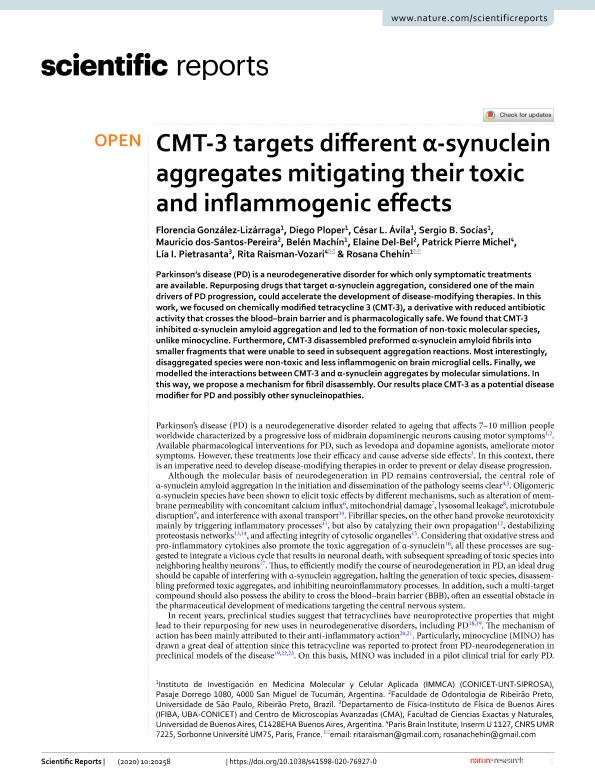Artículo
CMT-3 targets different α-synuclein aggregates mitigating their toxic and inflammogenic effects
González Lizarraga, Maria Florencia ; Ploper, Diego
; Ploper, Diego ; Avila, Cesar Luis
; Avila, Cesar Luis ; Socias, Sergio Benjamin
; Socias, Sergio Benjamin ; dos Santos Pereira, Mauricio; Machín, Belén; Del Bel, Elaine; Michel, Patrick Pierre; Pietrasanta, Lia
; dos Santos Pereira, Mauricio; Machín, Belén; Del Bel, Elaine; Michel, Patrick Pierre; Pietrasanta, Lia ; Raisman Vozari, Rita; Chehin, Rosana Nieves
; Raisman Vozari, Rita; Chehin, Rosana Nieves
 ; Ploper, Diego
; Ploper, Diego ; Avila, Cesar Luis
; Avila, Cesar Luis ; Socias, Sergio Benjamin
; Socias, Sergio Benjamin ; dos Santos Pereira, Mauricio; Machín, Belén; Del Bel, Elaine; Michel, Patrick Pierre; Pietrasanta, Lia
; dos Santos Pereira, Mauricio; Machín, Belén; Del Bel, Elaine; Michel, Patrick Pierre; Pietrasanta, Lia ; Raisman Vozari, Rita; Chehin, Rosana Nieves
; Raisman Vozari, Rita; Chehin, Rosana Nieves
Fecha de publicación:
12/2020
Editorial:
Nature
Revista:
Scientific Reports
ISSN:
2045-2322
Idioma:
Inglés
Tipo de recurso:
Artículo publicado
Clasificación temática:
Resumen
Parkinson's disease (PD) is a neurodegenerative disorder for which only symptomatic treatments are available. Repurposing drugs that target α-synuclein aggregation, considered one of the main drivers of PD progression, could accelerate the development of disease-modifying therapies. In this work, we focused on chemically modified tetracycline 3 (CMT-3), a derivative with reduced antibiotic activity that crosses the blood–brain barrier and is pharmacologically safe. We found that CMT-3 inhibited α-synuclein amyloid aggregation and led to the formation of non-toxic molecular species, unlike minocycline. Furthermore, CMT-3 disassembled preformed α-synuclein amyloid fibrils into smaller fragments that were unable to seed in subsequent aggregation reactions. Most interestingly, disaggregated species were non-toxic and less inflammogenic on brain microglial cells. Finally, we modelled the interactions between CMT-3 and α-synuclein aggregates by molecular simulations. In this way, we propose a mechanism for fibril disassembly. Our results place CMT-3 as a potential disease modifier for PD and possibly other synucleinopathies.
Palabras clave:
Alpha-synuclein
,
CMT-3
,
Aggregation
,
Parkinson´s
Archivos asociados
Licencia
Identificadores
Colecciones
Articulos (IMMCA)
Articulos de INSTITUTO DE INVESTIGACIONES EN MEDICINA MOLECULAR Y CELULAR APLICADA DEL BICENTENARIO
Articulos de INSTITUTO DE INVESTIGACIONES EN MEDICINA MOLECULAR Y CELULAR APLICADA DEL BICENTENARIO
Articulos(IFIBA)
Articulos de INST.DE FISICA DE BUENOS AIRES
Articulos de INST.DE FISICA DE BUENOS AIRES
Articulos(INSIBIO)
Articulos de INST.SUP.DE INVEST.BIOLOGICAS
Articulos de INST.SUP.DE INVEST.BIOLOGICAS
Citación
González Lizarraga, Maria Florencia; Ploper, Diego; Avila, Cesar Luis; Socias, Sergio Benjamin; dos Santos Pereira, Mauricio; et al.; CMT-3 targets different α-synuclein aggregates mitigating their toxic and inflammogenic effects; Nature; Scientific Reports; 10; 1; 12-2020; 1-17
Compartir
Altmétricas



